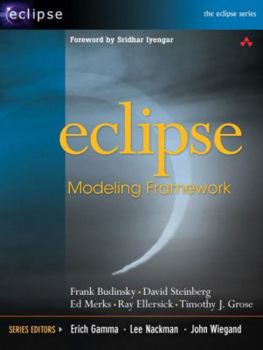Eclipse Modeling Framework
A guide to the Eclipse Modeling Framework (EMF), this text shows how EMF unifies three important technologies: Java, XML and UML. It provides an overview of the EMF classes including a complete quick... This description may be from another edition of this product.
Format:Paperback
Language:English
ISBN:0131425420
ISBN13:9780131425422
Release Date:January 2003
Publisher:Addison-Wesley Professional
Length:680 Pages
Weight:2.25 lbs.
Dimensions:1.4" x 7.2" x 9.1"
Customer Reviews
3 ratings
Best and Only Book on EMF
Published by Thriftbooks.com User , 20 years ago
This is the best and only work on the Eclipse Modeling Framework, which is the code generation engine built into the Eclipse IDE. It's a solid work, but it's one flaw is that it is neither a completely how-to book, nor is it completely architectural work, so it will probably frustrate most readers to some degree. This is the only reason I didn't give it a perfect rating.
Significant Productivity Gains
Published by Thriftbooks.com User , 20 years ago
If you have used Eclipse to program Java, you might have gotten comfortable with its capabilities. Very intuitive and kindly donated by IBM to open source. So when I opened this book, I anticipated oodles of helpful tweaks and shortcuts.But not so. IBM has indeed provided these in the book. But their goals were far more ambitious. The Eclipse Modelling Framework is a serious effort to incorporate into a development environment java, XML and UML. They found, perhaps correctly, that most Java programmers, including, and maybe especially the experienced ones, don't really use UML much. Okay, as an afterthought, to document a code base upon a major release. But rarely as a starting point. So one intent is to seamlessly let java programmers incorporate UML. More strongly, they claim that EMF lets you define a model in any of java, XML or UML. Then simply clicking a button will make EMF generate the other 2 forms. The greatest payoff for this is that it lets programmers, who may not be fluent in UML, make a graphical UML model and thence have EMF make the java code stubs. Much less error prone than doing it manually. There is an analogy here with Spice, if any of you have an electrical engineering background. Until the late 80s, if you wanted to model a circuit in Spice, you typically drew it by hand on paper. Then you manually transcribed these into a text file of netlists that was input into Spice. Slow and very error prone. Then along came MicroSim, Carver Mead's Magic program and others, that let you construct a circuit diagram on a console, and from which you could press a button and a Spice input file would be made. Much more productive.The book offers a similar gain in productivity. All you are asked to risk is your time in understanding the book.
Essential EMF Reading
Published by Thriftbooks.com User , 20 years ago
If you are doing modeling already you will find this book invaluable, if you are on the fense tetering between like and dislike for modeling this book will push you over the edge to loving it.The authors go through each of the aspects of EMF in detail so you can not only build a great model for your application but also explain what is happening so that you understand what is going on within the framework.My only negative comment is the inclusion of what amounts to java doc in the last 250 pages. The book would have been just as good without the extra weight.All around a great book and worthy of purchase.





